After a decade and a half of combat boots designed to pound the desert sand, the next boot in the Marine Corps sea bag may be designed with the jungle in mind.
The Marine Corps started a hunt for a new tropical-weather boot in December 2015 at the behest of Commandant Gen. Robert Neller. At the time, the boot was envisioned as an optional piece of gear that Marines could purchase through their local exchanges based on need. But now, officials are exploring the possibility of tweaking the new tropical design to replace the current hot-weather combat boot, which would make the future tropical boot standard issue for Marines.
"We were given by Gen. Neller two directions: continue working on the tropical boot, and look for ways to improve the current Marine Corps combat boot," Todd Towles, project officer for the clothing team at Marine Corps Systems Command, told Military.com.
Towles said Neller asked officials to enhance durability, cut down on combat boot weight and dry time, and develop a self-cleaning outsole that would shed dirt and mud. He also requested a sole that could be replaced by a cobbler, giving Marines the choice of repairing boots with worn-out soles instead of buying a new pair.
"General Neller is big on providing Marines with options in the footwear realm," Towles said.
It will likely be a year or more before a decision is made about whether to pursue an issued tropical combat boot or keep it optional and modernize the combat boots already available to Marines. During that time, the tropical prototypes will be put through their paces -- literally -- as they undergo intensive wear and comfort testing in Hawaii and in boot camp at Marine Corps Recruit Depot San Diego.
Marine Corps Systems Command officials have learned from experience that creating an all-in-one boot that purports to accomplish every task is a tall order. In late 2015, Neller directed a halt to plans to make the Rugged All-Terrain boot -- a staple of combat in Afghanistan -- mandatory for all Marines. The Corps had been set to phase out the Marine Corps Combat Boot in favor of the RAT boot, but reversed course with Neller's order.
The boot excelled in the desert, Towles said, but the outsole lacked the ruggedness needed for training in garrison.
"Although the boot did great in Afghanistan, once you put it on the foot of that recruit and he was doing his close-order drill, left-right-left, 24/7, it just couldn't withstand it," he said.
There are currently four companies who have produced tropical boot prototypes under consideration by the Marine Corps: Rocky Boots, Bates Footwear, Altama, and Danner.
This summer, two separate wear tests will take place involving the prototypes, Towles said. In Hawaii, about 400 Marines from 3rd Battalion, 3rd Marines will take part in a multi-month final user evaluation of boots from all four companies beginning the fourth week in June. They'll wear the boots into the fall, and then participate in focus groups and detailed user reports, Towles said.
The second test will involve about 200 San Diego recruits, who will put one of the four prototypes through their paces. The test will be held sometime between July and September and is exclusively designed to test the durability of the boots' outsoles. Though Marines are deployed around the world, Towles said, nowhere do boots see harsher conditions than at the feet of recruits on the drill field.
"It's incredible, the wear and tear that these recruits put on a pair of boots," he said. "So we know, based off of their field training, their close-order drill, and just day-to-day being in that boot for x amount of hours, it's where we need to verify that that boot can withstand the rigors of the Marine Corps."
There's no experience required for this test, Towles said. Officials with Marine Corps Systems Command do not even plan to survey the recruits; they will merely collect the boots and evaluate the wear and tear on the outsole. This test may be what determines whether the tropical boot has a place in the Marine Corps sea bag.
"We might go to the recruit depot and once we put the outsole in that environment, the outsole might fail," Towles said. "So we might identify, well, you know what, it's not designed for that environment. So then we'd focus on different ways to improve the Marine Corps combat boot."
Many decisions have yet to be made. At the end of the user evaluation phase, Marine Corps leaders can either opt to select one of the four bootmakers' prototypes as a ready-to-purchase off-the-shelf option, or they can evaluate survey feedback and write their own internal specification, beginning a new contracting process. Those decisions will likely be made in mid-2018, after officials have completed the intensive process of sorting through a "data dump" of survey feedback, Towles said.
Regardless of whether the planned tropical boot becomes issued gear, development will continue, Towles said.
While Marines once deployed primarily to desert combat environments in Iraq and Afghanistan, units now routinely deploy all over the world, with unit rotations in Japan and Australia, among other destinations.
"The tropical boot, it may not be as durable as the Marine Corps combat boot. We’re making it lighter, giving it ways to dry out faster, and possibly giving it a different kind of outsole," Towles said. "Sometimes there's a tradeoff you have to do in this business. But for that Marine in that environment, a tropical environment, it's going to help him complete his mission at a better rate than the Marine Corps combat boot."
-- Hope Hodge Seck can be reached at hope.seck@military.com. Follow her on Twitter at@HopeSeck.





























